Purslane. My new favorite edible weed. If you missed my post on just how incredibly nutritious this herb is, you’d better go catch up!
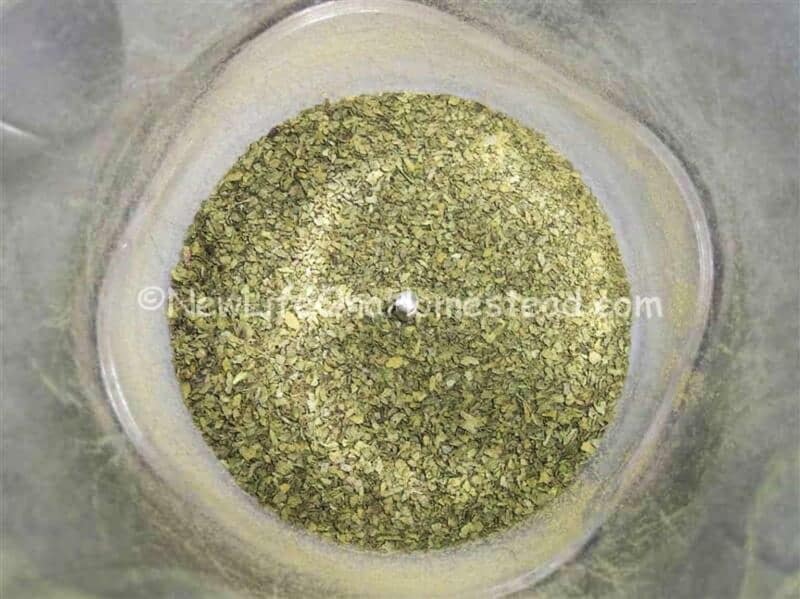
After discovering this super food in my garden, I decided to let it go crazy in one of my empty raised beds. And boy did it go crazy! I had fun experimenting with it before it came time to clear out the bed to make room for my new raspberry bushes.
Purslane makes a great thickening agent, much like cornstarch. Here’s how to turn it into a superfood powder to add to your favorite soups, stews, gravies or even shakes!
What Exactly is Purslane?
Purslane is an annual herb that is part of the Portulacaceae family, which also includes portulaca, claytonia, and montia. It is native to Eurasia and can now be found on every continent except Antarctica.
This plant is considered a weed by many because it is very difficult to get rid of once it has taken root. However, this so-called weed is actually quite nutritious and has many health benefits. It’s loaded with vitamins and minerals within its milky sap.
In addition to being nutritious, this wild herb has many culinary uses. It can be eaten raw in salads or cooked in soups and stews. The leaves have a slightly sour taste similar to lemons or rhubarb. The stems are more crisp and crunchy and can be used as a garnish or added to stir-fries.
What Does Purslane Do for the Body?
Also known as portulaca oleracea, purslane is a common weed that grows in many gardens and lawns. But don’t be so quick to pull it up next time you see it! This nutritious little plant actually has a lot to offer. Read on to learn more about the many health benefits of this “weed.”
This herb is an excellent source of omega-3 fatty acids. In fact, it contains more omega-3 fatty acids than any other leafy green vegetable.
Purslane is also a good source of vitamins A and C, as well as magnesium, calcium, and potassium. This combination of nutrients makes it a healthy and delicious food to eat.
It’s high water content also makes it a refreshing and hydrating food – perfect for hot summer days.
Harvesting Purslane
If you’re interested in harvesting this weed from your garden (or even from a nearby park or roadside), here are a few tips to help you get started.
First, pick a bunch of healthy looking purslane.:The best time to harvest the plant is in the morning after the dew has evaporated but before the sun gets too hot.
Look for plants that are growing in full sun and has healthy, bright green leaves. Avoid any plants that look wilted or have yellowed leaves.
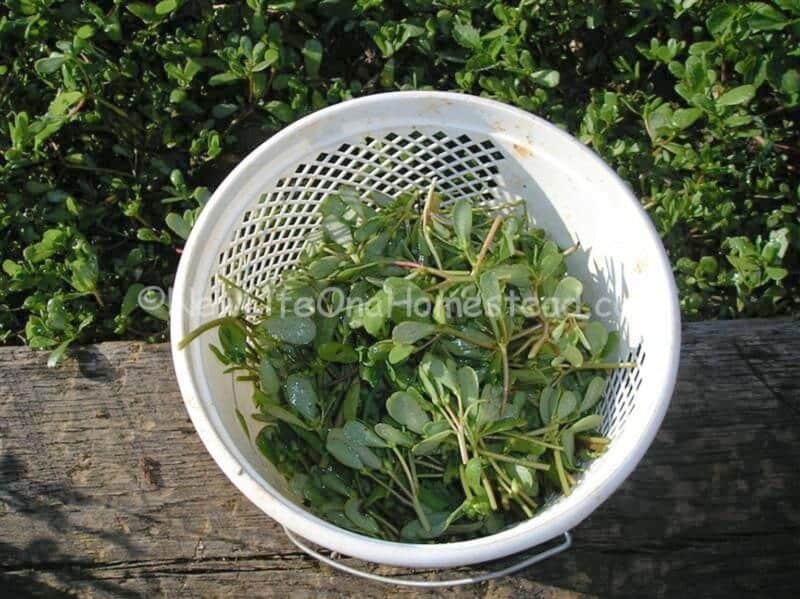
Cut the stems of the purslane close to the ground using gardening shears. Give the plant a good shake to remove any dirt or bugs.
Drying Purslane in a Dehydrator
Wash the leaves well. You wouldn’t want any dirt or bugs in your powder:
Then spread them out onto a towel to dry.
Pull the leaves off of the stems, and place them single layer on a dehydrator rack, or on a cookie sheet if drying in the oven. This would make a great activity for children to help with. Discard the stems, or feed them to your chickens.
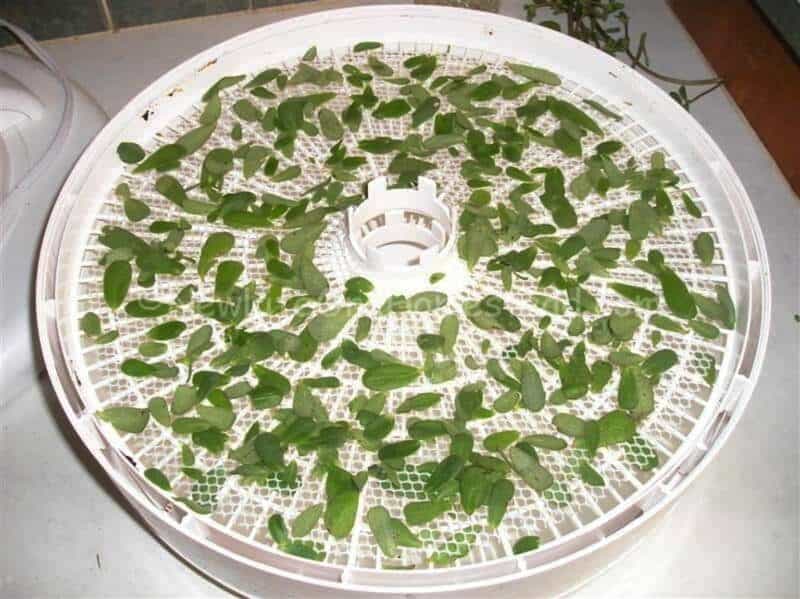
You’ll need a mesh screen or something similar to keep the leaves from falling through the trays after they’ve dried.
I used the ‘fruits and vegetables’ drying setting on my dehydrator, since these leaves are very succulent. The temperature is 135F (57 C).
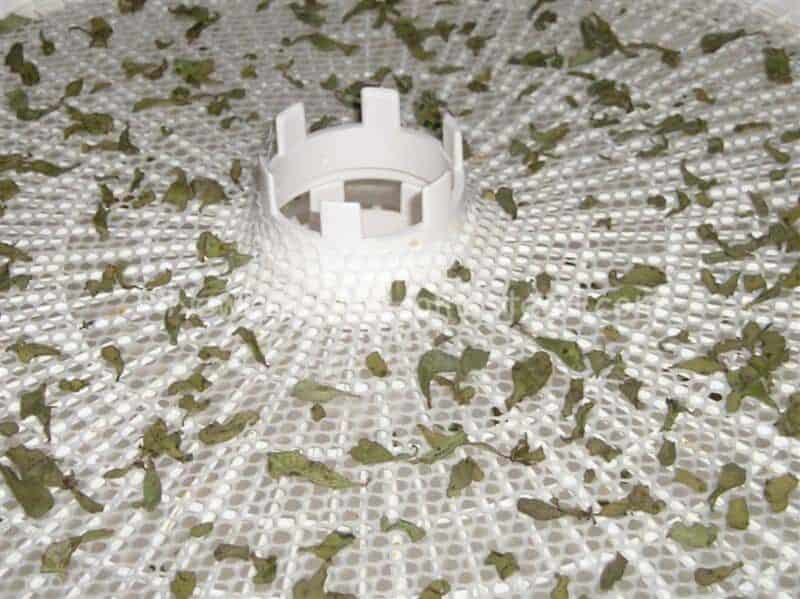
Using an Oven to Dry Purslane
If using an oven, set it to the lowest setting possible, and keep an eye on it to make sure it doesn’t burn. It took about 12 hours to dry completely. It should be brittle, indicating that it is done.
Next, place the dried leaves in a food processor or blender, and process until it turns to a powder:
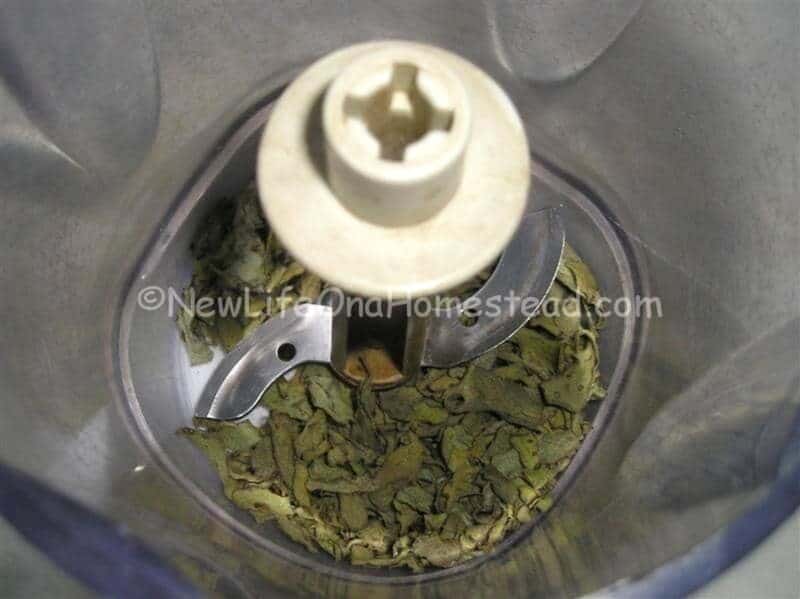
Mine turned out to be a coarse powder, but that was just fine. I stored it in an empty spice jar. You’ll need a lot of purslane to make a significant amount of powder.
The first time I experimented with this process, I only filled one dehydrator tray with leaves; I got about 1 1/2 Tbsp of powder from this amount.
Can I Hang Purslane to Dry?
One popular way to dry purslane is by hanging it upside down in small bundles. To do this, tie the stems together with string or twine and hang them in a cool, dark place with good airflow.
Another option is to lay the plant material out on a wire mesh screen or cheesecloth and set it in a warm, dry place until the leaves are crisp. Whichever method you choose, be sure to keep an eye on your purslane and check it regularly until it’s fully dried. Once it’s crispy all the way through, store it in an airtight container and enjoy it throughout the year!
How Do You Store Purslane Long Term?
If you have an abundance of purslane, you may be wondering how to store it so that it stays fresh and edible for as long as possible.
Besides drying purslane, as described above, you have a few other options for preserving it. Read on to learn how to store purslane properly.
Store in the Fridge
You can also store purslane in the refrigerator. To do this, wash it thoroughly, and remove any yellow flowers or seed pods. Chop the purslane into bite-sized pieces and place it in a moisture-proof container such as a glass mason jar or plastic storage container. Place a paper towel on top of it to absorb any excess moisture. Seal the container tightly, and store it in the refrigerator for up to five days.
Can You Freeze Purslane?
Purslane is a succulent plant that is known for being quite heat-sensitive. This means that the plant does not do well in extreme heat or cold. However, with proper care, you can definitely freeze the leaves and enjoy them throughout the winter months.
When freezing purslane, it is important to blanch the leaves first. Blanching helps to preserve the color and texture of the leaves. To blanch, simply put the leaves in boiling water for two minutes before placing them in ice water. Once the leaves are cool, drain them and pat them dry with a paper towel.
Next, place the leaves on a baking sheet lined with parchment paper and place them in the freezer. Once they are frozen solid, transfer the leaves to a freezer-safe container or plastic bag. When you’re ready to use them, simply take out as many leaves as you need and thaw them in the refrigerator overnight.
Can I Freeze Dry Purslane?
Purslane is a succulent plant, which means that it contains a lot of water. In order to freeze dry your leaves, you will need to remove as much of the water from the plant as possible. This can be done by blanching the leaves in boiling water for two minutes, then cooling them in ice water. Once the leaves are cool, squeeze them gently to remove any excess water.
Next, spread the leaves in a single layer on a baking sheet and place them in the freezer. Freeze the leaves for at least 24 hours, or until they are completely frozen solid. Once the leaves are frozen solid, place them in a freeze dryer and let the machine do its work. Freeze drying can take anywhere from 24 to 48 hours.
Once the purslane leaves are dried, store them in an airtight container in a cool, dark place. Dried leaves will last for up to one year.
How to Use Purslane
This leafy green is related to the portulaca flower, and its scientific name is Portulaca oleracea. It is succulent, so it retains a lot of water, which makes it perfect for summer dishes. It has a slightly sour taste with a hint of salty flavor. The texture of the leaves are thick and slightly rubbery.
Purslane can be used in many different dishes, but it is most commonly used in salads or as a sandwich filling. The slightly sour and salty flavor pairs well with cucumber, tomatoes, yogurt, eggs, pork, and lemon juice.
My favorite recipe for fresh or dried purslane is to make a sandwich with tomatoes, cucumber, onion, olive oil, sliced and pickled beets, vinegar, and a dash of lemon juice. This nutritious plant adds a bite of zest to the sandwich mixture.
You can also eat it by itself, ideally with a bit of salt and pepper and some lemon juice to help bring out the flavors.
The flavor of the dried purslane reminds me of dried parsley. It’s very mild and nice. I used my powdered purslane in a bean soup last night in place of cornstarch, and it thickened up very nicely. I am anxious to make a lot more for regular use in my kitchen.
You can use it as a substitute for parsley in most cases, putting it in dishes like eggs, pasta, and soups. You can even make pesto out of the herb or pickle it!
FAQ
Purslane is a hardy plant that can tolerate a wide range of temperatures. The lowest temperature that it can tolerate is 32 degrees Fahrenheit. At this temperature, it will go dormant and stop growing.
Purslane is a hardy, drought-tolerant plant that is often grown as a summer annual. However, in warm climates, it can persist year-round and may even reseed itself as a perennial.
Purslane can also be preserved by pickling, freezing, freeze drying, or drying. To pickle the leaves, simply wash the herb and pack it into jars with vinegar and spices. Drying is also a simple process; just tie the stems together and hang them in a cool, dark place.
This wild herb has a crispy texture and a slightly sour taste. It is a good source of vitamins A, C, and E, as well as omega-3 fatty acids. It can be eaten raw or cooked.
Have you ever dried purslane? What’s your favorite way to use it?

A city girl learning to homestead on an acre of land in the country. Wife and homeschooling mother of four. Enjoying life, and everything that has to do with self sufficient living.

With all the fatty acids in purslane I was told by someone not to dry it. Are you sure it’s okay? I’d like to dry it and make a supplement out of it.
I was just reading an article (https://www.ncbi.nlm.nih.gov/pmc/articles/PMC4573115/) that to get the most benefit from purslane it shouldn’t be dried over 50 Celsius (122F) . I have a herb setting on my dehydrator (excalibur) so I’m going to use that to remove some moisture before I put it in my freeze dryer. (Harvest right)
Your article was very informative and I should have realized how much water content purslane had in it being a succulent but I didn’t and am thankful that you went over that fact.
It’s such a power plant that it’s amazing that more people don’t know about it…
Oh lastly purslane does have an evil cousin….it’s called spurge , hairy spurge and spotted spurge. It is very poisonous ..to me looking at both plants I can totally see the difference and would not mistake one for the other but many people do and they tend to like to grow next to each other.
My neighbor is a pretty good cook for his 80 some year old mom, himself, & me occasionally. I introduced him to Purslane, lambs quarter, wood soral. Purslane comes up every spring at the NE corner of the shop. He still won’t ear the stems even after I did in front of him. I powdered 2 quarts of lambsquarter & seeking other plants to do. Enjoyed all examples! Considering what newscasts are predicting, learning about wild edibles/medicinals is vital.
I started making asparagus powder and then zucchini powder this summer. Purslane powder is next on the list. Looking forward to some nutritious yummy soups when the weather gets cold in Wisconsin. I will blanch it first like I did with the other veggies so it dries faster.
I eat wild harvested purslane every year. I dry other leafy vegetables but did not know I could dry purslane. I don’t own a dehydrator and it heats up the house too much to use the oven. What I came up with is drying foods on top of the frig. It works very well and quickly. I put a large tray or cookie sheet lined with parchment paper then stack wire racks(used to cool baked goods)with parchment paper on top of each rack. so far the herbs, kale, lettuces, spinach, assorted greens, chives flowers, carrot tops have all dried, retained their color and texture in two to three days. Hope this helps. Marilyn
My mom being Mexican would fix it like spinach , pick it in the morning give it a good washing never used stems , would get a bit of oil with butter , throw in a couple of garlic cloves minced, silvers of onions , throw in slices of fresh tomatoes, then the leaves of “ verdolaga “ aka purslane, would add spices like salt pepper, celery salt , let it cook a bit , sometimes , jalapeños that would make our day everybody would eat it bcoz she would tell us it was “ Popeyes spinach “
I found that it takes a long time for the whole purslane plant to dry in the dehydrator, because it is succulent. Therefore I have frozen the washed, and coarsely chopped, whole plants. After a day, I placed them in the dehydrator. Now the drying went much faster.
Eva, I think it is a good solution. thanks.
we saw in garden as wild but after knowing the uses of purslane and benefits, i ll make powder it
Use window screen for small items like purslane and sunflower seeds. It will prevent it from falling through.
Superb answer.
I bought the seeds from Mckenzie seeds and its growing beautiful. I use it every day in my salads. I need to know how to preserve it now. I will try drying it and make powder. I would love to have the recipe for the relish?????? I bet it is delicious.
Simply put in old pickle juice any flavor, I imagine jalapeno juice will work too. Fill jar, cover and shake, I shake every now and again.
Do you refrigerate it?
I’ve been weeding purslane for years. Not anymore! Just discovered how great it is. I already make a number of powders (zucchini, pumpkin, spinach, mushroom, chive) and now I can add purslane. I’m excited about this!
Interesting, how do you use these powders from vegetables that you dry?
Anne
I eat it fresh on salads, a nice lemony flavor. I also eat and dehydrate the whole stem and leaves. Why throw it away.
Yes, I jus eat the whole thing. Put it on a sandwich or in a salad.
There is a great Mexican dish called verdolagas (which is also another name for the purslane). It calls for tomatillos, serrano pepper, some onion and garlic, and some optional cheese. After you cook it, you eat it in a tortilla. Really good. I have soooo much purslane in my garden right now. I’m trying to process it every which way I can so it doesn’t go to waste or seed. I even have pickled some. There is a great book called “The Wild Wisdom of Weeds” that talks about the 12 or so edible weeds that are found anywhere in the world. Purslane is one of them. It’s a great book to have.
Kirsten, I have a really yummy recipe for Huevos con Verdolagas if you wanna give it a try! 🙂
https://www.newlifeonahomestead.com/cooking-with-purslane-recipe-huevos-con-verdolagas/
I also have the book you recommended. It’s one of my favorite foraging books!
how do you pickle it? I have acres of it.
Apparently the seeds can be used to replace poppy seeds in cooking.
Jamie Oliver has a great recipe for Purslane Pesto…!!
…Parpadelle with Spinach and Purslane Pesto
Cut some purslane for my salad with stems, put it in bottom of my salad bowl to try it for the first time, decided stems were too tough to eat. Hours later started to empty salad bowl and noticed purslane was still green and looked like it was trying to resume growing. So I washed off the salad dressing and stuck it in a pot of dirt. The next few mornings noticed the stuff was beginning to grow! It had no roots when I stuck it in the dirt! Now it is getting taller and greener. Heartiest stuff I have ever seen! I am eating it in salads almost every day now. There is plenty in the garden growing ‘wild.’
I pick a large handful of fresh purslane in the morning, rinse and throw the whole bunch in the Vitamix and make a green smoothie. Stems and leaves. I’ve been cutting off the roots just because I’m not 100% sure they’re good for you, (but I’ll bet they’re fine!). Next thing I’m looking for online is lacto-fermenting it – but this page looked interesting too – thanks for sharing!
Emily, I wonder the same thing, as I’m wanting to make kimchi out of it.Let me know your thoughts. Lily
Does this work for portulaca too, since they are cousins???
Not sure about that one, Nancie. Sorry!
purslane is a wild portulaca. Not like the flowering portulaca, but related.
I think you could dry the purslane without having removed the stems, and then remove the stems after it has dried. That way the thing you’re drying would be bigger and you wouldn’t need to worry about little things falling through. Incidentally, something I read said the stems are edible too.
Also, I have dried slices of zucchini (with seeds removed) and then ground it up into a powder to use in soups, and this worked well. This is the same process I used with the zucchini.
Before drying my purslane, I steam-blanch it (stems & all) to stop enzyme action & more importantly to soften cell walls of stems for better drying in my dehydrater. To steam it I use a spaghetti-pot steamer & steam for 45 – 60 seconds, then run under cold water to cool rapidly, then into dehydrater at 115 – 120 deg setting for 24 hrs or until brittle enough to grind into powder or flakes…….
Usually it’s best picked early in season when plump , before flowering…Also I usually cut with scissors , leaving 2 or more leaves on residual stem , which gives additional crop to harvest after re-growth……
I also usually put early-growth purslane “weeds” in with my pots of vegetable plants ( tomatoes, peppers, cauliflower, cabbage etc. grown in pots ) to harvest through-out growing season for an almost continous supply….. A “great beneficial weed ” !
Great advice, Fred!
Hello Kendra
Do you know if sun drying or drying purslane at a low temperature preserves the essential oils or are they ruined by any drying?
Thanks!
Sarah,
I don’t really know. I would imagine the oils are mostly lost during any drying, though that would just be a guess. Sorry I’m not much help!
I discovered purslane in my garden this year (2nd yr garden). I have given it and lamb’s quarters an area in the garden just like the other veggies and herbs. Otherwise they get kinda pushy!
I didn’t know if it would dry hanging upside down like I do with most all my herbs. It is drying now and doing beautifully. In fact, the whole plant, stalk and all is still perky. The leaves are flat and deep green rather than puffy and succulent. I hung it a little over a week ago. I just pulled it out from the root (like, do I need to worry more will be there?) and hung it upside down in a mostly shady, dry spot.
I found that it will turn black in the frig after about three days in a mixed salad though so heads up there (summer abundance management!).
Love the connection here!
Christie
Thanks so much for all of the helpful purslane tips, Christie! Hang drying it is a great alternative to using a dehydrator 🙂
Wonderful information, thank you so much! I love to nibble on them fresh when gardening, use them in smoothies, and was really wondering how to preserve them for the rest of the year. Drying and making powder seems just perfect, and just being able to hang them to dry, well, that is just the perfect option! Thank you!
Be careful. Don’t confuse purslane and spurge. Spurge has flat leaves and is very milky and poisonous.
I would like to know the Relish recipe that Kim mentions she uses the stems for. I heart they have tons of nutrients as well, Hook me up. ! XO
Thanks ! CarolGay
Great article! I have had my eye on purslane now for a while
And just started to harvest it . I was searching for something about
Drying it so was excited to find you blog.
Can I dry the stem too , I’m sure why not huh? It supposedly has all the
Vitamin C? Right? It’s super hot here in no cal so I thought if try to
Sun dry it then powder it . I was reading Wise Woman~ susun weed~ she had a great
Article on purslane and some real good recipes. I actually have not eaten it yet
I’ve just been warming up to it~ wow is it packed with calcium, magnesium & potassium ~ talk about Gstorade
Why do people spend money on that stuff?
Any thoughts on drying in sun or drying the stem too ?
Do you have a favorite recipe for a salad w purslane?
Thanks carolgay
Hi Carol Gay,
You can eat/dry the smaller stems, just don’t use the very thick main stems. I’m sure you could dry it in the sun, it would just take longer than in an oven or dehydrator. As for recipes, I love tossing it into scrambled eggs and cooking slightly, or putting fresh leaves/small stems in a regular ol’ garden salad with homemade italian dressing 🙂 Have fun!
Just getting into purslane, like to know if you can dry the stem as well, I am going to make powder but would like to know the other recipes you have for it please
I used ,the stems to make relish found a great recipe.
Hi Kim,
I’d love to hear the recipe, if you wanna share 🙂
Sounds awesome! That’s great that you can use it for corn starch! Our purslane did really well this spring, but got eaten up the rest of the year. I kept thinking another plant would pop up and take the last ones place and better that than our other more “prized” veggies, but the new plants kept getting eaten too. I do still have a bag in the freezer, although I don’t think it’s enough to make much dried. I should probably just use it as is in soup or stir fry. Thank you for your awesome suggestions!
Good way to not have gmo corn in my food, using purslane instead of cornstarch.
Would love to be able to try this. Maybe if I find any and get the courage to do so.
I am always afraid I will miss identify something, and someone may get sick.
Thanks for your wonderful post!
LindaG,
It’s definitely important to correctly identify a plant before consuming it, but don’t be intimidated! Purslane is one of the easiest things to positively identify 🙂 The internet is a wonderful source for helping one to identify a plant through close-ups and thorough descriptions. You can do it!!
Can’t get it confused with that other plant Hairy Spurge ( I think that’s the name) it’s poisonous.
Oh my goodness…we have this in our flower beds already! (I just read the post from back in May.) Hubby has been trying to kill it all year! So…I will pull some up and put them in a planter to grow in a more confined area. Again – THANK YOU!
Awesome, Meg!! That’s great news 🙂
This is brilliant!
We are on a grain/dairy/sugar-free diet and this would be great to use in place of cornstarch! Hubby likes gravies and thick soups. I will have to find out where to get some to plant next year to dry.
Thank you for posting this!
It may grow wild right in your yard? 🙂
I sure wish I would have known about this during the summer! We just moved to our new farm but our old place had a ton of Purslane and Lamb’s Quarter. I hope we have some here but so far we haven’t seen any. Maybe next year when we get the garden going. I’ll definitely keep this in mind. Thanks!
Missy,
Maybe it’ll pop up at your new place 🙂